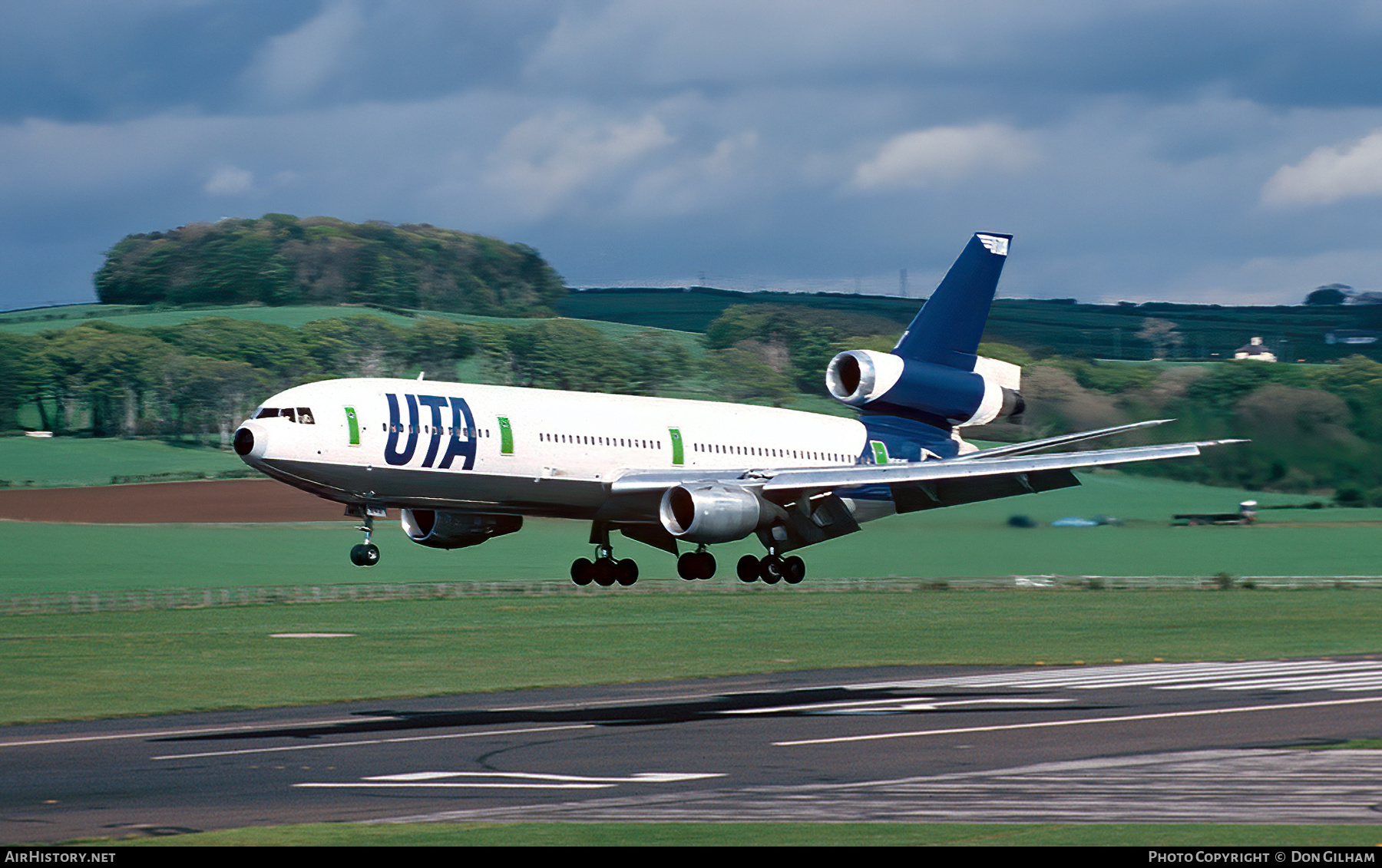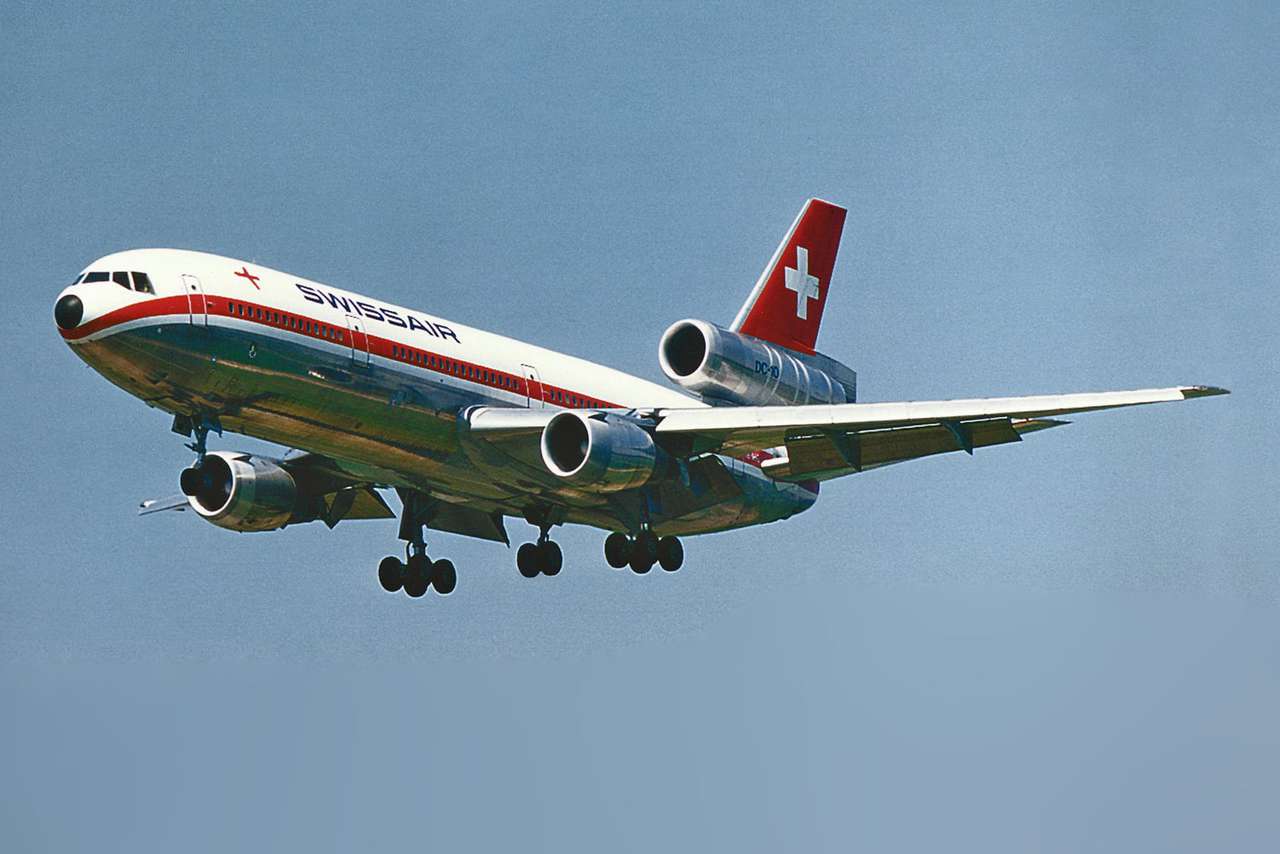Aircraft Dc10 - This article uses bare URLs that are uninformative and susceptible to link decay. Consider turning them into full citations to ensure the article remains verifiable and maintains a consistent citation style. There are several templates and tools available to help with formatting, such as Reflinks ( documentation ), reFill ( documentation ), and Citation bot ( documentation ). (September 2022) (Learn how and how to remove this template message)
The DC-10 Air Tanker is a series of American wide-body jet air tankers in service as an aerial firefighting unit since 2006.
Aircraft Dc10

Operated by the Joint Technical vture 10 Tanker Air Carrier, the aircraft is a converted McDonnell Douglas DC-10-30 wide-body passenger aircraft used primarily to fight wildfires in rural areas. The turbofan-powered aircraft carries up to 12,000 US gallons (45,000 liters) of water or fire retardant in an external belly-mounted tank, parts of which can be released in eight seconds. There are currently four tanker aircraft in service, all DC-10-30, with the call signs Tanker 910, 911, 912 and 914. The original Tanker 910, DC-10-10, entered service in 2014.
Mcdonnell Douglas Dc 10 10
New Mexico-based 10 Tanker Air Carrier began research in 2002 into the development of Next Generation air tankers. The company's staff is stacked with a long history of heavy jet operations, modifications and ownership. After two years of research into aerial firefighting requirements and future directions, 10 Tanker selected the DC-10 type for development. In March 2006, the US Federal Aviation Administration (FAA) issued a Supplemental Type Certificate (STC) for modifications to the DC-10 aircraft to be used for airborne liquid dispersion.
10 Tankers received 14 CFR Part 137 operational certification for aerial firefighting and Interagency Board for Air Tankers (IAB) approval for agcy use.
The first converted aircraft, a McDonnell Douglas DC-10-10 registered as N450AX, was first delivered to National Airlines in 1975 as a civilian airliner and later flew for Pan Am, American Airlines, Hawaiian Airlines and Omni Air International.
The conversion of the original airframe to a firefighting aircraft was a joint venture between 10 Tanker Air Carrier of San Carlos, CA and Omni Cargo Conversions, and the conversion work was performed by Victorville Aerospace at the Southern California Logistics Airport in Victorville, CA.
Hawaiian Airlines Flight Hal481
Air tank modifications can be performed on the DC-10-10 or DC-10-30 series and include the addition of an external tank and associated systems and support structure.
Water or retarder is carried in three snow tanks. The tanks have internal lugs to prevent fluid displacement (and consequently change the center of gravity) in flight and sit with 15 inches (38 cm) of ground clearance. All three tanks can be filled simultaneously on the ground in eight minutes. The retarder is gravity-fed from the tank and the wheel load is ejected in eight seconds, although the actual rate of descent is computer-controlled by the flight crew to produce the desired retarder spread along the lines of fire.
The aircraft is capable of deploying a retardant line 300 feet (91 m) wide and 1 mile (1.6 km) long.

External delay tanks are designed to be filled from standard 3-inch (76 mm) glass couplings. Using one, two or three hoses, tanks can be filled as quickly as base filling capabilities allow, typically within 15-20 minutes. Tanks are vented to atmosphere through a vt system mounted on top of each tank to ensure sufficient air enters the tanks during deceleration and filling. Precision flow meters are part of the installation.
Ansett Airlines Of Australia
The number of drops he can make in a day is limited only by the time it takes to refuel the aircraft with water/fire retardant and fuel, and the need for a suitable landing site that can be far enough away from the fire.
However, despite its size, field experience demonstrated the aircraft's versatility in all types of terrain and in all atmospheric conditions considered suitable for fixed-wing operations in the Fire Traffic Area (FTA).
Unlike most existing and proposed large air tankers (LATs), the DC-10 reaches the firefighting area significantly less than its certified maximum gross takeoff weight (MGTOW). This is mainly due to the reduction of the fuel load carried on firefighting missions.
Initially, the aircraft was intended to be used primarily in California, with tire condition service provided from Victorville Air Force Base at Southern California Logistics Airport, but in 2007, Cal Fire began establishing a second base of operations at Sacramento McClellan Airport in Northern California.
How Many Mcdonnell Douglas Dc 10 's Are Still Flying ?
10 Tanker Air Carrier announced in 2007 that another aircraft would be converted to tanker use for the 2008 fire season.
DC-10s operate with a flight crew of three, a pilot, copilot and flight engineer. The tanker works with lead aircraft and can be an effective tool in extinguishing forest fires by working directly with ground resources. 10 The Tanker Air Carrier added a second DC-10 (N17085), previously flown by Continental Airlines, to its fleet in July 2008 for on-call use. In late 2014, the company added two additional DC-10s previously in service with Omni and Northwest Airlines, N612AX and N522AX, which were Tankers 910 and 912. The original aircraft, the N450AX, was subsequently withdrawn from service in November 2014.
Accepted by the US Forest Service (USFS) for use as air tankers in 2006 and since then flown under state and international contracts, DC-10s were first put into direct service by the USFS in 2011.

In 2006, the aircraft was used under a limited evaluation contract with the State of California. During the 2006 season, the aircraft was offered on an "as-needed" basis, which came at $26,500 per flight hour (minimum three hours) and an activation delay of between 12 and 24 hours.
How Mcdonnell Douglas Missed The Big Twin And Disappeared
For the 2007-2009 fire seasons, California Governor Arnold Schwarzenegger approved a contract worth $5 million per year for the exclusive use of the aircraft, or an average of about $41,000 per day for the June 15-October 15 fire. Season; that was an additional $5,500 per flight hour.
The exclusivity of the contract meant that the aircraft was always ready for dispatch and could catch fire within an hour of being called.
In 2011, the exclusive use agreement was terminated by the State of California due to state budget constraints.
Tanker 910 was first used in July 2006 to fight the Sawtooth Complex Fire in San Bernardino County, California. While the fire was burning, Tanker 910 was initially grounded in Victorville, California because it was not cleared for operation by Cal Fire. Victorville Mayor Mike Rothschild became concerned and investigated why it didn't fly, revealing the approval process could take up to six months. After calling California Secretary of State George Runner, Cal Fire was able to complete the necessary training and paperwork within days, and the California certification was approved on July 15, 2006.
The Dc 10: This Wide Body Jetliner Never Shook Its Bad Reputation
The following day, on July 16, an aircraft dropped two drops on the Sawtooth Fire, and Cal Fire personnel reported that "the two fire drops contributed more to the suppression of the fire than 12 helicopter drops in the last 10 days."
Later that month, the aircraft was used to fight several small fires in California, as well as a fire at the Columbia compound in Washington. In September 2006, Cal Fire launched the Tanker 910 for Day Fire use.
Under the terms of an exclusive use agreement, Tanker 910 was activated against White Fire in 2007, where it flew twice before the incident. After repairs were completed, it was commissioned in August 2007 for use in the Great Zac Fire, the second largest wildfire in modern California history.

Tanker 910 was also deployed for the September 2007 Moonlight Fire in Plumas County. On October 22, Tanker 910 joined efforts to extinguish several wildfires in California, including the Slide Fire and a grass fire near Lake Arrowhead. The next activation occurred on November 24, 2007, when the tanker joined the fight against the Coral fire near Malibu, California.
Continental Airlines Dc 10
In June, Governor Arnold Schwarzegger activated Tanker 910 in response to the Humboldt Emergency in Butte County, California, to contain a fire that burned more than 20,000 acres (8,100 ha). It took off from Sacramento McClellan Airport in northern California. Hill said he made 14 drops of a total of 168,000 US gallons (640,000 L) of retardant to extinguish the raging fire. The plane also participated in the defense of Big Sur in June-July.
Australia has arrived in Melbourne, Australia for the fire season. Leased by the National Air Fire Service on behalf of the State Government of Victoria, the DC-10 began operations in Australia in early January 2010 based at Avalon. The then Victorian premier, John Brumby, described the tanker leasing as part of a record funding programme.
Dc10 link, airplane dc10, dc10 audio, tannoy dc10, cioks dc10 link, dc10, cioks dc10, uta dc10, dc10 dyson, dc10 fire fighting aircraft, dc10 aircraft, thermo haake dc10